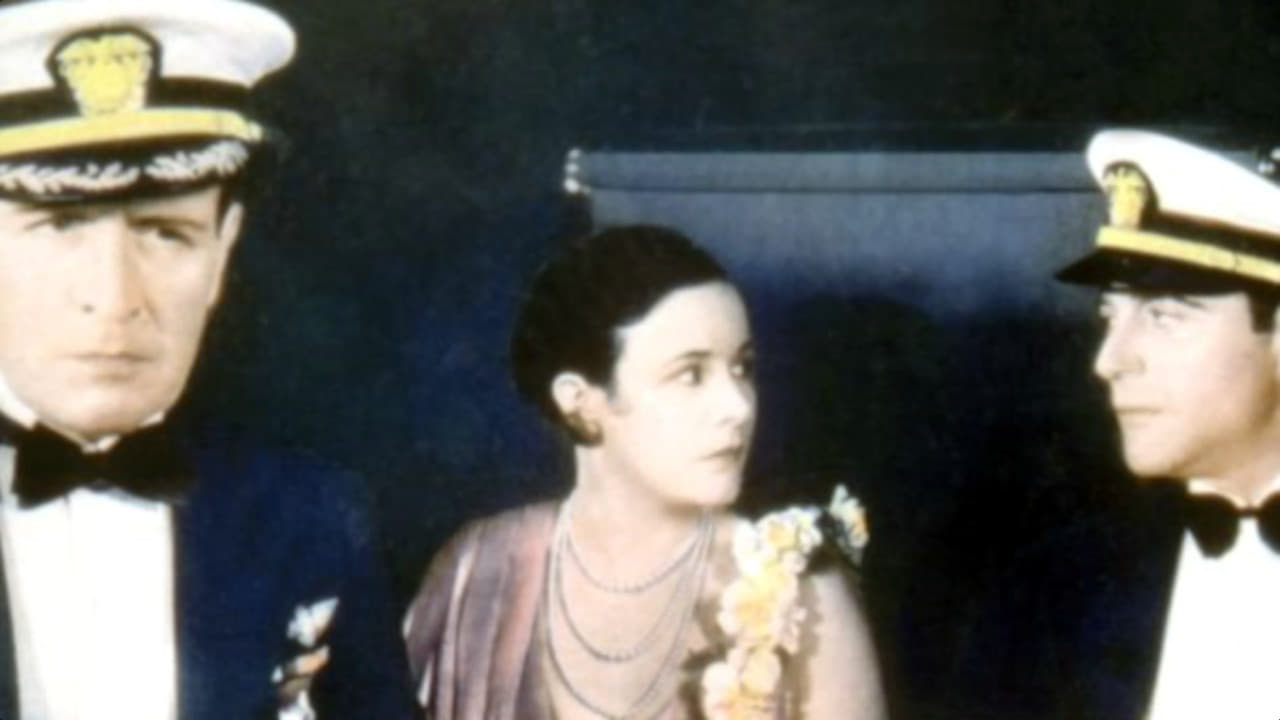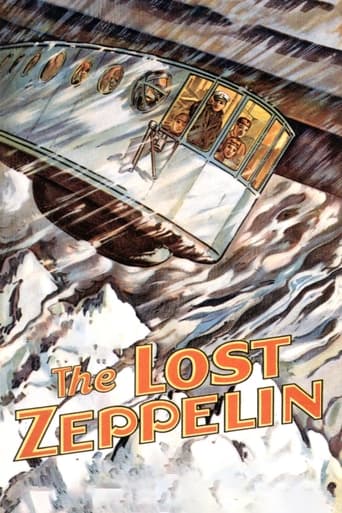

Conway Tearle (Commander Hall), Virginia Valli (Mrs Hall), Ricardo Cortez (Tom Armstrong), Duke Martin (Lieutenant Wallace), Kathryn McGuire (Nancy), Winter Hall (Wilson).Director: EDWARD SLOMAN. Screenplay: Frances Hyland. Dialogue: Charles Kenyon. Story: Jack Natteford. Film editors: Martin G. Cohn, Donn Hayes. Photography: Jackson Rose. Art director: Hervey Libbert. Set decorator: George Sawley. Special effects: Jack Robson, Kenneth Peach. RCA Sound System. A Tiffany-Stahl Production. Recording engineer: Jerry Eisenberg. Sound technician: John Buddy Myers.Copyright 10 December 1929 by Tiffany Productions, Inc. New York opening at the Gaiety: 1 February 1930. U.S. release: 20 December 1929. 8 reels. 6,882 feet. 76½ minutes.SYNOPSIS: A dirigible crash-lands near the South Pole.COMMENT: The Tiffany-Stahl company bills itself as "The Better Entertainment". Better than what, one might ask? The New York Times reviewer had his finger on the pulse when he described all three of the principal performances as "not especially praiseworthy", the story as both unintelligent and uninteresting, the plotting as "clumsy", and the special effects as "far from impressive". Well, maybe he was a little over-hard on the effects. Aside from one or two remarkable achievements like the fall down the snow- cliff, realistic they are not. But some of the glass shots of the dirigible on the ice have a certain pictorial splendor, and some of the model- work is not bad. All the same, the story is trash, the principals are a dull, lifeless trio. Mr. Cortez tries hard to instill a bit of vigor into a thankless role, but wooden Tearle and that impossibly painted doll with her silly little voice, Virginia Valli, are a dead loss. Ed Sloman's tepid, static, colorless direction is no help either.
... View MoreVirginia Valli had been a stenographer who broke into films in 1915. Her beauty found her fame and she made many films during the twenties. With talkies though, her voice was too high pitched for the primitive microphone technology - she only made a few before retiring for marriage with Charles Farrell. In "The Lost Zeppelin" she does play a very whiney woman, Miriam, who while married to Commander Donald Hall (Conway Tearle) is desperately in love with Tom Armstrong (Ricardo Cortez). The scene on the couch where she is imploring Armstrong to tell her the truth about her husband's bravery would have most people running from the room holding their ears!!Both Tearle and Cortez play their parts with a stiff upper lip: if you have ever seen Tearle in movies you know it is his usual acting style but Cortez I think was still finding his talkie feet and within a year would be his usual relaxed charming self in films like "Behind Office Doors" and "The Maltese Falcon".Even though Hall is devastated by seeing his wife in the arms of another man the show must go on - the show being an expedition to the South Pole and, you guessed it, Hall and Armstrong are going together!! Even though Tiffany ("the better entertainment") was the top of the tree as far as independent studios went, it is an amazingly ambitious epic. The first 20 minutes did drag but it may have been to lure patrons in for some talk, for once in the air it really took off! The South Pole was very topical at the time as Admiral Byrd was making his first expeditions. The visual effects are terrific, the zeppelin in the air looked pretty realistic as it puttered through the clouds and above the polar naval base. Kenneth Peach Sr. A.S.C. was the cameraman and Jack Robson was a specialist in mechanical effects.A storm disables the zeppelin and it crashes through the ice. Hall and Armstrong explore the surrounding area but the man with them dies in an avalanche and they return to find the rest of the crew dead. The sound effects do get tedious but try watching Paramount's "The Studio Murder Mystery" thunderstorm scenes and you will find this movie isn't so bad. Primitive sound effects was a great leveller of studios both big and small. Meanwhile Miriam is brought up to date by constant newscasts and it is only at the end with the inevitable drawing room showdown that the film becomes static and betrays it's early talkie status. Even the clichéd scene where Hall forces Armstrong to return to base and a hero's welcome while he faces the unknown is spruced up with a twist in the last few minutes.Highly Recommended.
... View MoreI struggled to stay with this film to see it to the end. I give it two stars just for a try at a plot. Besides some very good silent films of the 1920s, I've rated about a dozen talkies of 1929 from 7 to 10 stars. Those were all produced by Paramount, MGM, Warner Brothers and a British studio."The Lost Zeppelin" was made by one of the 80 or so poverty row studios that existed in the early years of movie making. Tiffany-Stahl lasted longer than most, from 1921 to 1931, and turned out 70 films in that time. This was one of its last. And this film is a good example of why it and the host of poverty row studios didn't last. The few good directors and technicians that started in the lower echelons eventually made it into the big studios or went with a successful independent that would later make it big or merge into one of the other studios. Normally, I wouldn't bother to review a film I rate so low. But since this is now out on DVD, I thought prospective viewers might like more comment than has been posted on IMDb to this time. I won't urge folks not to watch this – but you should know what to expect before you plunk down cash to buy or rent it. Indeed, I had some inkling of what it was about, but I wanted to see it for myself. And, I'm glad I did – because I now know what the very cheap poverty row films were like.Everything about this film is poor, with the possible exception of the sound from the dialog. The sets are very amateurish and poor – such as an airplane door that slides open. No kidding – just like a sliding door in a house. Then, when a crew person opens the door, it starts to fall out of its track and he shoves it back. The airplane engine noise is some strange irritating sound created by sound effects, and doesn't sound anything like a plane engine. The film quality itself is barely watchable. The script is something that a third-grade student might create today. But the directing and acting are the very worst. Conway Tearle and Ricardo Cortez had small movie careers through the 1930s. But those were mostly in B films. The rest of the cast are actors who couldn't make the transition from silent to sound. Virginia Valli had made more than 60 films in the silent era; but after this, she made only two more before retiring from films at age 35. That's when many of the best actors begin to shine. The acting is very hammy in this, and one can see long pauses and long glances at the camera – techniques used in the silent films to allow subtitles to show. While the voices of all this cast were OK, they apparently couldn't transition to real acting. There were many silent film stars who didn't succeed in sound films because their unusual voices didn't fit their images in the minds of the movie-going public. So, this isn't likely to be very entertaining; but if you want to see an example of the hundreds and even thousands of early films that aren't around anymore – and of the type of films put out by the short-lived and over-night cheap studios, then you may enjoy watching "The Lost Zeppelin."I found this bit of trivia that movie buffs might enjoy. Apparently, MGM bought Tiffany's original film library and used it for fuel in "Gone with the Wind." It went up in flames in the scene of the burning of Atlanta. I doubt if it was very expensive kindling.
... View MoreTHE LOST ZEPPELIN (1929) a Tiffany Studio release (who ever they were) features a typical service triangle with the romance of early aviation. Zeppelins (ie Dirigibles) were hot stuff at this time popularized by their successes during World War I (WWI) and commercial traffic developed by Germany postwar.The best part of the film is the second half that concentrates on the Antartic flight of the titled character, it's wreck and the rescue of the survivors. There is some references to the disaster of the Scott expedition (1912) where the entire polar party died on the way back from the pole. For those unfamiliar with the story read the Roland Huntford book 'The Last Place on Earth' for the triumph of Amundsen and the defeat of Scott.The film is technically adapt for the time but you can see the problem the actors where having with the early sound equipment. The actors freeze and will not move even their heads in case they miss their marks and the microphones. In many scenes voice overs were used to cover multiple actors. To show how fast things improved in just two (2) years watch DIRIGIBLE (1931) Columbia Pictures, Frank Capra directing. Pretty much the same stuff, romance triangle and Antartic expedition though this time with AeroPlanes (Ford TriMotor) and two (2) Zeppelins. Balloons, Blimps and other period aircraft were also featured. The picture benefits from two (2) years of technical advancements and we would rate it six (6) stars ******.
... View More